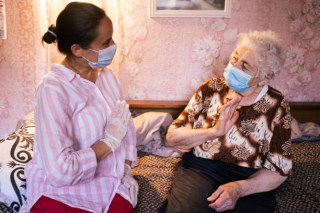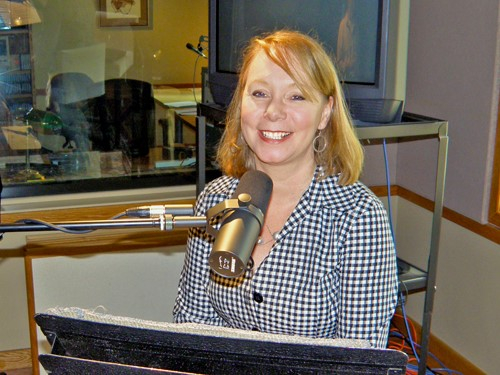The McGill International Palliative Care Congress has always promoted the work done by communities around the world - including advocacy initiatives, volunteers and support for caregivers - and this year’s inaugural all-day Teresa Dellar Community Seminar is no different.
I invited my co-chair for the Community Day, Virtual Hospice Executive Director, Shelly Cory, to share her thoughts on why this day is so important and why you should attend.
Shelly Cory [SC]: For me the most inspiring examples of palliative care are when local people, through sheer determination and creativity, leverage their communities’ strengths to overcome obstacles to meet palliative care needs: whether it be delivering palliative care to children in Indonesia, to people in rural communities in Zimbabwe, or to Indigenous communities in Canada. The vast majority of palliative care is provided in community, and outside healthcare settings, by family and friend caregivers - a fact that is largely overlooked and poorly resourced. There is so much we can learn from each other. I’m most looking forward to listening and being inspired by the speakers and participants. The Congress is a great space for the exchange of diverse experiences and perspectives and our extraordinary line-up of panelists will be a catalyst for a very enlightening and inspiring day.
Suzanne O'Brien [SOB]: I agree with you. We are blessed to have extraordinary community leaders on our panels this year, including Pamela Grassau, Holly Prince, Dr. Naheed Dosani and Dr.Amit Arya, some of whom have worked with you on VH (Canadian Virtual Hospice) projects. The day will address issues of healthcare inequities, social justice and lessons learned from the pandemic in many areas of community practice. It will challenge us, at a community level to balance some of these inequities.
SC: I was unable to attend Congress in 2018 as I was the primary caregiver to my Mom who had rapidly progressing ALS. Providing and coordinating care in our rural community of 500 reinforced that in the end it all comes back to community and that where you live shouldn’t affect how you die. Nurturing communities’ capacity and confidence to support end of life and grief can fundamentally impact the experience for the dying, their caregivers and other family and friends. Coming together to share successes and challenges over the course of the day will, I hope, reinvigorate and inspire us to be catalysts for ongoing progress.
SOB: Two years of the pandemic saw caregivers often excluded from direct care and support of loved ones in end-of-life care. What have we learned?
 SC: The pandemic brought our resilience, our creativity, and our vulnerabilities into sharp focus. It underscored many fault lines in our healthcare systems, limitations in community supports and the meaning and importance of presence. Caregivers were excluded from the bedside to mitigate risk, and many family members found themselves assuming caregiving roles they would otherwise not have contemplated, with vastly reduced supports. It was devastating for families and those living their final days in health facilities to be separated at a time when being together is so crucial and for those working in palliative care to support rules that contravened the fundamental principle of palliative care. We were reminded, starkly, that grief supports are a neglected part of health systems both for those who access and provide services.
SC: The pandemic brought our resilience, our creativity, and our vulnerabilities into sharp focus. It underscored many fault lines in our healthcare systems, limitations in community supports and the meaning and importance of presence. Caregivers were excluded from the bedside to mitigate risk, and many family members found themselves assuming caregiving roles they would otherwise not have contemplated, with vastly reduced supports. It was devastating for families and those living their final days in health facilities to be separated at a time when being together is so crucial and for those working in palliative care to support rules that contravened the fundamental principle of palliative care. We were reminded, starkly, that grief supports are a neglected part of health systems both for those who access and provide services.
The pandemic highlighted the need for a revolution in long-term care and home care. We are all weary and as health systems face growing staff shortages it is incumbent upon communities and upon all of us to maintain that momentum for critical change.
SOB: In an increasingly virtual world, Virtual Hospice has been the leader. I refer to your learning modules all the time. What initiatives are you most proud of?
SC: Over the last number of years, we’ve turned our efforts to working with groups who felt “invisible” in the heath system to co-design tailored resources to help meet their unique palliative care needs and to elevate these needs within health systems and in the public policy arena or leverage these products as a catalyst for change. We’ve worked shoulder-to-shoulder with Indigenous Peoples; immigrants and refugees; families caring for seriously ill children; teens and young adults with palliative care needs; people who identify as Two-Spirit and LGBTQ+. We’ve become an international community of communities working with common purpose and mutual respect to better understand and meet diverse palliative care needs. We’ve elevated grief and grief literacy with the public and as a public policy issue through MyGrief.ca and Kidsgrief.ca, and the establishment of the Canadian Grief Alliance, which is supported by more than 160 health care organizations.
SOB: I love your choice of the word “co-design” – involving communities in designing programs which matter to them; which meet their needs and culture. I think this is the very essence of our day at the Congress. I can’t wait to see you again and to chair this day with you; to hear more about new Virtual Hospice projects, to connect with colleagues and new attendees, to re-imagine programs and re-invest energy in creating community responses to community issues. As you said earlier, Shelly, this is the heart of palliative care.
Please join us on October 19th for the Teresa Dellar Community seminar.
To learn more about the Congress and to register.

